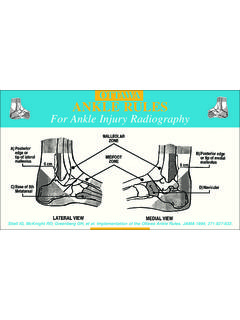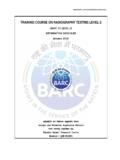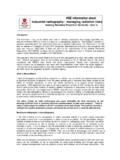Transcription of SUMMARY OF CURRENT UK LEGISLATION AND …
1 Whaites and Drage: Essentials of Dental radiography and Radiology 5e, ISBN 978-0702045998, Elsevier, June 2013 SUMMARY OF CURRENT UK LEGISLATION AND GUIDELINES LEGISLATION There are two sets of regulations in the UK governing the use of ionizing radiation. They both form part of The Health and Safety at Work Act 1974 and comply with the provision of the European Council Directives 96/29/Euratom and 97/43//Euratom: The Ionising Radiations Regulations 1999 (SI 1999 No. 3232) (IRR99) which replace the Ionising Radiations Regulations 1985 (SI 1985 No. 1333). The Ionising Radiation (Medical Exposure) Regulations 2000 (SI 2000 No. 1059) (IR(ME)R 2000) which replace the Ionising Radiation (Protection of Persons Undergoing Medical Examination or Treatment) Regulations 1988 (SI 1988 No. 778), to which additional amendments were made in 2006 and 2011-The Ionising Radiation (Medical Exposure) (Amendment) Regulations 2006 (SI 2006 ) and The Ionising Radiation (Medical Exposure) (Amendment) Regulations 2011 (SI 2011 ).
2 General points regarding the Ionising Radiations Regulations 1999: Concerned principally with the safety of workers and the general public but also address the equipment aspects of patient protection Came into force on 1st January 2000 Replaced the Ionising Radiations Regulations 1985 Enforced by the Health and Safety Executive (HSE). General points regarding Ionising Radiation (Medical Exposure) Regulations 2000: Concerned with the safety of patients Came into force on 13th May 2000 Replaced the Ionising Radiation (Protection of Persons Undergoing Medical Examination or Treatment) Regulations 1988 Defined new positions of responsibility, namely: - the employer - the referrer - the practitioner - the operator Enforced in the UK by: - the Care Quality Commission (CQC) in England - the Healthcare Inspectorate Wales (HIW) in Wales - the Scottish Executive (SE) in Scotland - the Regulation and Quality Improvement Authority (RQIA) in Northern Ireland.
3 Whaites and Drage: Essentials of Dental radiography and Radiology 5e, ISBN 978-0702045998, Elsevier, June 2013 Guidelines In the last 20 years, four major sets of UK guidelines have been published, namely: Guidelines on Radiological Standards in Primary Dental Care published in 1994 by the National Radiological Protection Board (NRPB) and the Royal College of Radiologists. These guidelines and their recommendations covered all aspects of dental radiology and set out the principles of good practice - much of what was recommended in 1994 is still relevant today. Selection Criteria for Dental radiography 1st Edn 1998, 2nd Edn 2004, 3rd Edn 2013 published by the Faculty of General Dental Practice (UK) of the Royal College of Surgeons of England. These booklets reviewed the evidence for, and provide guidance on, which radiographs are appropriate for different clinical conditions and how frequently they should be taken.
4 Several of the recommendations in the 2013 3rd Edn are reproduced in appropriate chapters in Essentials of Dental radiography and Radiology 5th Edn 2013 with kind permission of the Faculty of General Dental Practice (UK). Guidance Notes for Dental Practitioners on the Safe Use of X-ray Equipment published by the Department of Health in 2001 which brought together the requirements of IRR99 and IR(ME)R 2000 as they relate to dentists and included the principles of good practice established in the 1994 Guidelines. The main points and various extracts from these 2001 Guidance Notes are reproduced below with kind permission from the Radiation Protection Division of the Health Protection Agency (formerly the National Radiological Protection Board (NRPB). Guidance on the Safe Use of Dental Cone Beam CT (Computed Tomography) Equipment published by the Health Protection Agency in 2010. This document specifically covered the radiation protection requirements for CBCT, as this was not included within the 2001 Guidance Notes.)
5 The main points and various extracts from the 2010 CBCT Guidance are also reproduced below with kind permission from the Radiation Protection Division of the Health Protection Agency. NOTE: The summaries below are not intended to cover all aspects of the various guidance notes and LEGISLATION . The various publications mentioned above, particularly the 2001 Guidance Notes and the 2013 Selection Criteria, should be regarded as essential reading for all members of the dental profession, whether in general practice, dental hospitals or community clinics. The 2010 CBCT Guidance should be regarded as essential reading for all members of the dental profession involved with CBCT equipment. The Health Protection Agency will become part of Public Health England on 1st April 2013 and it is anticipated that their guidance documents will be available on-line from Public Health England via Whaites and Drage: Essentials of Dental radiography and Radiology 5e, ISBN 978-0702045998, Elsevier, June 2013 SUMMARY of the LEGISLATION and extracts from the 2001 Guidance Notes for Dental Practitioners on the Safe Use of X-ray Equipment Essential legal requirements of IRR99 Authorization.
6 Use of dental X-ray equipment for research purposes should be in accordance with a generic authorizations granted by the Health and Safety Executive (HSE). Notification. The HSE must be notified of the routine use of dental X-ray equipment and of any material changes to a notification including a change in ownership of the practice of a move to new premises. Prior risk assessment. This must be undertaken before work commences and be subject to regular review. All employers are recommended to record the findings of their risk assessment, but it is a requirement for employers with five or more employees. A five-step approach is recommended by the HSE: 1. Identify the hazards ( routine and accidental exposure to X-rays). 2. Decide who might be harmed and how they might be affected. 3. Evaluate the risks and decide whether existing precautions are adequate or whether more precautions need to be taken. Implement additional precautions, if needed.
7 4. Record the findings of the risk assessment. 5. Review the risk assessment and revise it, if necessary. Restriction of exposure. There is an over-riding requirement to restrict radiation doses to staff and other persons to as low as reasonably practicable (ALARP) (see later). Maintenance and examination of engineering controls. Applies particularly to safety and warning features of dental X-ray equipment. Contingency plans. These should arise out of the risk assessment and be provided within the Local Rules (see later). Radiation Protection Adviser (RPA). A suitably trained RPA must be appointed in writing and consulted with to give advice on IRR99. The RPA should be an expert in radiation protection and will be able to advise on compliance with the Regulations and all aspects of radiation protection, including advice on: - controlled and designated areas for all radiation equipment - installation of new or modified X-ray equipment - periodic examination and testing of engineering controls, safety features and warning signals - systems of work - risk assessment Whaites and Drage: Essentials of Dental radiography and Radiology 5e, ISBN 978-0702045998, Elsevier, June 2013 - contingency plans - staff training - assessment and recording of doses received by patients - quality assurance (QA) programmes.
8 Information, instruction and training. Must be provided, as appropriate, for all persons associated with dental radiology. Designated areas. During an exposure, a controlled area will normally be designated around the X-ray set as an aid to the effective control of exposures. The controlled area may be defined within the primary X-ray beam until it has been sufficiently attenuated by distance or shielding and within of the X-ray tube and the patient. Normally, only the patient is allowed in this area. This can be facilitated by the use of appropriate signs. Radiation Protection Supervisor (RPS). An RPS - usually a dentist or senior member of staff in the practice should be appointed to ensure compliance with IRR99 and with the Local Rules. The RPS must be adequately trained, should be closely involved with the radiography and have the authority to adequately implement their responsibilities. Local Rules.
9 All practices should have a written set of Local Rules relating to radiation protection measures within that practice and applying to all employees. Information should include: - the name of the RPS - identification and description of the controlled area - SUMMARY of working instructions including the names of staff qualified to use the X-ray equipment and details of their training as well as instructions on the use of equipment - contingency arrangement in the event of equipment malfunction and /or accidental exposure to radiation. - name of the person with legal responsibility of compliance with the regulations. - details and results of dose-investigation levels (Note: A dose constraint of no higher than 1mSv per year is recommended as generally appropriate for practice staff from dental radiography ) - name and contact details of the RPA - arrangements for pregnant staff - reminder to employees of their legal responsibilities under IRR99. Classified persons.
10 Division of staff into classified and non-classified workers and the dose limits that apply to each group are discussed later. In dental practice, most staff are non-classified unless their radiography workload is very high. Duties of manufacturers. The installer is responsible for the critical examination and report of all new or significantly modified X-ray equipment, which should include: - a clear and unambiguous description of the equipment and its locations. Whaites and Drage: Essentials of Dental radiography and Radiology 5e, ISBN 978-0702045998, Elsevier, June 2013 - an evaluation of the acceptability of the equipment s warning signals. - an evaluation of the acceptability of the exposure control - confirmation that the equipment s safety features are in place and operating correctly ( beam dimensions and alignment, beam filtration and timer operation) - an overall conclusion as to whether or not the equipment s safety features are operating correctly, the installation is providing sufficient protection for persons from exposure to X-rays and whether the user has been provided with adequate information about proper use, testing and maintenance of equipment.







